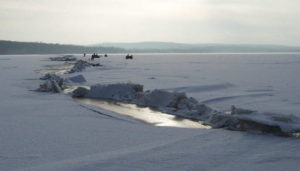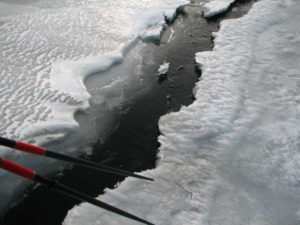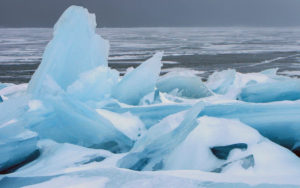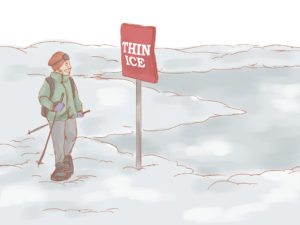What causes an Ice Pressure Ridge?
An ice pressure ridge results from a change in temperature which causes the ice to crack.
This forms a floating sheet of ice. When an area of open water is present the sheet of ice is able to move freely.
Think of an ice cube when you first put it into a glass of water. When exposed to the warmer water the ice cracks at the weakest part.
Where Does the Pressure Ridge Start?
A pressure ridge usually starts a few hundred feet off the shoreline in what would be 2-3′ of water in the summer. Up to this point, the ice is anchored to the bottom of the lake. The ice near the shore remains very stable and does not move from the shoreline.
Water begins at this point under the ice. The water gets deeper as you go out. Much like an ice cube, the ice will “crack” when exposed to pressure from winds or warmer temperatures.
If you have ever been on or near the ice in winter, you have heard the ice “crack”. The wind is generally blowing at these times or the ice may have been exposed to warmer temperatures. The ice builds up pressure at the open-water mark. The ice separates and “cracks”. This sound can travel for miles.
The pressure ridge may form anywhere there is thin or weak ice.
How does the Ice Pressure Ridge form?
With the ice near the shore securely anchored to the shoreline and the bottom, the floating ice on the outer side of the crack moves away from or along the shore with the wind. If the direction of the winds changes it moves
With the ice at the shore anchored to the shoreline, the floating ice on the outer side of the crack moves away from or along the shore with the wind. When the direction of the winds changes it moves back to the joint or along the joint again.
When the floating ice hits the stationary ice on the shore, pressure builds up and crushes the edges into pieces called “rubble”.
Some of the “rubble” sinks to the bottom due to weak ice under the top layer. This rubble forms the “keel” of an ice pressure ridge. The loose “rubble” continues to accumulate under the main shelf of ice until it hits the lake bottom.
When the “rubble” hits the bottom there’s no place for the “rubble” to go – except vertically. Now the accumulating rubble forms the “sail” on the upper part of the pressure ridge. The “sail” can be anywhere from inches high to 50 feet high depending on the winds and the strength or weakness of the ice.
When the “rubble” hits the bottom there’s no place for additional “rubble” to go – except vertically. Now the accumulating rubble forms the “sail” portion or upper part of the ice pressure ridge. The “sail” can be anywhere from inches high to 40 feet high depending on the winds and the strength or weakness of the ice.
How fast does the Pressure Ridge form?
A pressure ridge usually forms rapidly when the winds are blowing strong and steady. You need to be especially careful when approaching the pressure ridge because you don’t know how much solid ice remains.
Since the “rubble” below has been exposed to non-freezing temperatures, it starts to melt away. This results in a weak and fluctuating joint at the surface. The area around the ice ridge can be very dangerous.
Are there other signs of weak ice?
Slow melting ice will result in dark areas which means the water on top and below the ice is melting the ice away. Never go on this type of ice as it is very weak. Be careful around pressure ridges, they indicate the presence of weak ice.
Ever wondered what causes ice shoves?
See our next article on January 30th for an explanation.
Reminder
Pier & Waterfront Solutions specializes in ShoreMaster docks, lifts, and accessories both residential and commercial. We service the rest.
PWS is located in the center of Door County at 7325 St Hwy 57. Located 1 mile North of County MM (Hwy 42) and South of Sturgeon Bay at the intersection of Idlewild Road. Our staff looks forward to assisting you.
Want us to address a dock or boat lift topic for you? Feel free to give us a call.
Call Jerry at 920-493-4404 or Email Jerry@wisconsinpws.com for more information.









